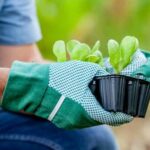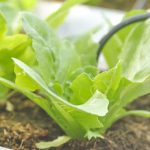Container vegetable gardening has become increasingly popular among urban dwellers and those with limited outdoor space. This method allows individuals to cultivate their favorite vegetables in containers, making it accessible to almost anyone. If you’re looking to start your own container vegetable garden but don’t know where to begin, a container vegetable gardening book can provide you with the guidance and inspiration you need.
One of the key benefits of container gardening for vegetables is its flexibility. Unlike traditional garden beds, containers can be placed on balconies, patios, or even windowsills, enabling you to grow fresh produce in any available space. Additionally, container gardening reduces the risks of soil-borne diseases and pests, making it a great option for beginners or those with limited gardening experience.
Choosing the right containers for your vegetable garden is crucial for the success of your plants. From size to material, there are various factors to consider when selecting containers that will promote healthy growth. In addition, understanding the essential tools and supplies needed for container vegetable gardening will help streamline the planting process and ensure that your plants receive the care they require.
Benefits of Container Gardening for Vegetables
Container gardening offers numerous benefits for individuals looking to grow their own vegetables. One of the main advantages is the versatility it provides, allowing individuals with limited space or no access to a traditional garden to still enjoy the pleasures of homegrown produce. By using containers, vegetables can be grown on balconies, patios, rooftops, or even indoors, making it accessible to urban dwellers and those in apartments.
Another benefit of container vegetable gardening is the ability to easily control the growing environment. Containers allow for better management of soil quality, drainage, and sunlight exposure, which are crucial factors in the success of a vegetable garden. Additionally, pests and diseases can be easier to manage in containers compared to traditional gardens, where they can quickly spread among plants.
Furthermore, container gardening offers the flexibility to move plants around as needed. This is particularly useful in areas where weather conditions may fluctuate drastically or when you want to rearrange your outdoor space for aesthetic reasons.
With a little creativity and planning, container vegetable gardening allows individuals to customize their growing space according to their needs and preferences. For more detailed information on maximizing the benefits of container vegetable gardening, consider exploring resources such as a reputable container vegetable gardening book for expert guidance and inspiration.
How to Choose the Right Containers for Your Vegetable Garden
Container selection is a crucial step in starting your vegetable garden. The type and size of containers can significantly impact the growth and health of your vegetable plants. When choosing containers for your garden, it is essential to consider factors such as material, size, drainage, and mobility.
Firstly, consider the material of the container. While clay pots are popular for their aesthetic appeal, they tend to dry out quickly and may require more frequent watering. On the other hand, plastic containers are lightweight and retain moisture better. Additionally, fabric grow bags are a versatile option that allows for air pruning of roots.
Secondly, make sure to choose containers that are large enough to accommodate the root systems of your chosen vegetables. Most vegetables need a minimum depth of 6-12 inches for healthy growth. Carrots and other root vegetables may require deeper containers.
Lastly, ensure that the containers have proper drainage holes to prevent waterlogging, which can lead to root rot. If the container does not have drainage holes, you can drill them yourself or use a layer of gravel at the bottom to allow excess water to escape. Additionally, consider the weight of the containers when filled with soil and plants, especially if you plan on moving them around your garden.
When selecting containers for your vegetable garden, keep in mind that creativity is key. Upcycled items such as old buckets, wooden crates, or even unused furniture can make unique and charming planters for your vegetables. By choosing the right containers for your garden, you set yourself up for a successful container vegetable gardening experience.
| Container Material | Recommended Container Types |
|---|---|
| Plastic | Lightweight and retain moisture well |
| Clay pots | Aesthetic appeal but dry out quickly |
| Fabric grow bags | Versatile option allowing air pruning of roots |
Essential Tools and Supplies for Container Vegetable Gardening
When starting a container vegetable garden, having the right tools and supplies is crucial for success. Whether you are a beginner or a seasoned gardener, investing in quality equipment will make your gardening experience more enjoyable and productive. Here are some essential tools and supplies you will need to kickstart your container vegetable garden:
- Containers: Choose containers that are the right size for the vegetables you want to grow. Make sure they have drainage holes at the bottom to prevent waterlogging.
- Soil: Use high-quality potting mix specifically formulated for container gardening. Avoid using garden soil, as it may not provide adequate drainage or nutrients.
- Trowel: A hand trowel is essential for planting seeds, seedlings, or transplanting small plants into your containers.
- Watering can or hose: Proper watering is key to a successful container garden. Invest in a watering can with a long spout for precise watering or use a hose with a gentle spray nozzle.
- Fertilizer: Choose a balanced fertilizer suitable for vegetables in containers. Look for slow-release options to provide nutrients gradually over time.
Having the right tools and supplies on hand will help you maintain your container vegetable garden efficiently and effectively. With proper care and attention, your plants will thrive and reward you with a bountiful harvest of fresh, homegrown produce.
For more in-depth guidance on selecting the best tools and supplies for your container vegetable garden, consider exploring resources such as Container Vegetable Gardening Book This book provides expert advice on everything from choosing the right containers to proper maintenance techniques. By expanding your knowledge through informative books like these, you can elevate your container gardening skills and grow an abundance of delicious vegetables right at home.
Best Location and Sunlight Requirements for Your Container Garden
When setting up your container vegetable garden, one of the most crucial factors to consider is the location and sunlight requirements for your plants. Vegetables generally require at least 6-8 hours of direct sunlight each day to thrive and produce a bountiful harvest. Therefore, it is essential to choose a location for your containers that receives adequate sunlight throughout the day.
Choosing the Right Spot
Look for a spot on your balcony, patio, or deck that gets ample sunlight. Avoid placing your containers in shady areas or spots that are blocked by buildings or trees. South-facing locations typically receive the most sunlight, making them ideal for growing vegetables in containers. If you have limited space, consider using mobile containers on wheels so you can move them around to follow the sun.
Understanding Sunlight Requirements
Different vegetables have varying sunlight requirements, so it’s essential to consider this when selecting which plants to grow in your container garden. Leafy greens like lettuce and spinach can tolerate partial shade but still need at least 4-6 hours of sunlight daily.
Fruiting vegetables such as tomatoes, peppers, and cucumbers require full sun to produce well. Be sure to research the specific sunlight needs of each vegetable you plan to grow and place them accordingly in your container garden.
By carefully selecting the right location and ensuring proper sunlight exposure for your container vegetable garden, you can set yourself up for success and maximize your harvest. Remember that light is a critical element in plant growth and development, so prioritize this aspect when planning out your garden setup. For more in-depth information on light requirements for different vegetables in container gardening, consult a reputable container vegetable gardening book for guidance and inspiration.
Choosing the Right Vegetables for Container Gardening
Container gardening is a versatile and accessible way to grow vegetables, herbs, and fruits at home, especially for those with limited garden space or poor soil conditions. When choosing the right vegetables for container gardening, it is essential to consider the size of the plant, its root system, and the amount of sunlight it requires. Some vegetables are more suited for container gardening than others due to their compact growth habits or shallow root systems.
Popular vegetables that thrive in containers include tomatoes, peppers, cucumbers, lettuce, radishes, and herbs like basil and oregano. These plants do well in pots with sufficient drainage holes and adequate space for their roots to grow. Additionally, bush varieties of beans and peas are also suitable for container gardening as they don’t require extensive vertical support like their climbing counterparts.
One important consideration when choosing vegetables for container gardening is the climate in your region. Some plants prefer cooler temperatures while others thrive in warm weather. Be sure to select vegetable varieties that are well-suited to your local climate to ensure a successful harvest. For further guidance on selecting the best vegetables for your container garden, you may refer to a reputable container vegetable gardening book that offers expert advice and recommendations tailored to different growing conditions.
| Popular Vegetables for Container Gardening | Climatic Suitability |
|---|---|
| Tomatoes | Warm climates |
| Lettuce | Cooler temperatures |
| Peppers | Warm climates |
Tips for Proper Soil Preparation and Fertilization
Proper soil preparation and fertilization are essential steps in ensuring the success of your container vegetable garden. Without the right soil composition and adequate nutrients, your plants may struggle to thrive and produce a bountiful harvest. In this section, we will discuss some tips to help you prepare your soil and fertilize effectively for healthy vegetable plants.
Choosing the Right Soil Mix
When it comes to container gardening, choosing the right soil mix is crucial. A good quality potting mix specifically designed for vegetables is recommended, as it provides the necessary drainage, aeration, and nutrients needed for healthy plant growth. Avoid using regular garden soil, as it can become compacted in containers, leading to poor root development and water retention issues.
Adding Organic Matter
To improve the fertility of your soil mix, consider incorporating organic matter such as compost or well-rotted manure. These natural materials not only provide essential nutrients for your plants but also help improve soil structure and moisture retention. Mix in a generous amount of organic matter into your potting mix before filling up your containers to ensure a nutrient-rich growing environment for your vegetables.
Fertilizing Your Container Vegetables
In addition to using a quality potting mix and organic matter, you may also need to supplement with fertilizers throughout the growing season. Consider using a balanced fertilizer formulated specifically for vegetables in containers. Follow the instructions on the product label for proper application rates and timings to avoid overfeeding or nutrient deficiencies. Regular feeding can promote healthy growth and abundant yields from your container vegetable garden.
By following these tips for proper soil preparation and fertilization, you can provide your container vegetable plants with an optimal growing environment that will support their health and productivity throughout the season. Remember that healthy soil leads to healthy plants, so investing time in preparing your soil correctly will pay off in abundant harvests of fresh home-grown vegetables.
Watering and Maintenance Techniques for Healthy Vegetable Plants in Containers
Proper watering and maintenance are essential for the health and productivity of vegetable plants grown in containers. The key to successful container vegetable gardening lies in providing the right amount of water at the appropriate times. Overwatering can lead to root rot, while underwatering can result in wilting and poor fruit development. To ensure optimal growth, it is important to monitor the moisture levels of the soil regularly.
One effective technique for watering container vegetables is the “bottom-up” method, which involves placing containers in trays filled with water and allowing the roots to absorb moisture from the bottom up. This helps prevent overwatering and promotes healthier root development. Additionally, using a soaker hose or drip irrigation system can ensure that water reaches the roots directly without wetting foliage, reducing the risk of disease.
Regular maintenance tasks such as pruning, staking, and harvesting are also crucial for promoting healthy growth in container vegetable gardens. Pruning helps improve air circulation and sunlight exposure, reducing the risk of fungal diseases. Staking provides support for tall or vining plants like tomatoes and peas, preventing them from bending or breaking under their own weight. Harvesting vegetables at their peak ripeness not only ensures maximum flavor but also encourages plants to produce more fruits throughout the growing season.
For further guidance on watering techniques, maintenance tips, and more, consider investing in a reputable container vegetable gardening book. These resources offer valuable insights from experienced gardeners and experts, providing detailed instructions on how to care for your plants effectively. By referring to a trusted container vegetable gardening book, you can enhance your knowledge and skills to create a thriving edible garden right at your doorstep.
Recommended Container Vegetable Gardening Books for Further Reading and Inspiration
For those looking to deepen their knowledge and skills in container vegetable gardening, turning to expert resources such as books can be incredibly beneficial. Here is a list of highly recommended container vegetable gardening books that cover a wide range of topics from beginner basics to advanced techniques:
- “The Complete Container Herb Gardening Book” by Jessica Walliser – This comprehensive guide not only covers herbs but also provides valuable insights into growing vegetables in containers. From selecting the right containers to troubleshooting common issues, this book has it all.
- “Container Gardening Complete: Creative Projects for Growing Vegetables and Flowers in Small Spaces” by Jessica Walliser – Another gem by Walliser, this book offers creative ideas for maximizing your container garden’s potential. With step-by-step instructions and beautiful photos, this book will inspire both beginners and experienced gardeners.
- “Container Vegetable Gardening: Growing Crops in Pots in One Year Round Part-Time Step-By-Step Guide for Beginners” by Dominique Montoya – Ideal for beginners, this book simplifies the process of growing vegetables in containers. Montoya breaks down each step in an easy-to-understand manner, making it accessible for all skill levels.
Whether you are just starting out or looking to take your container vegetable gardening to the next level, these books offer valuable insights, tips, and inspiration to help you succeed. Remember that continuous learning is key to becoming a successful gardener, so don’t hesitate to delve into these recommended reads and expand your gardening knowledge.
Remember that while these books provide valuable information and guidance on container vegetable gardening, practical experience and experimentation are also crucial components of mastering this rewarding gardening method. So don’t be afraid to get your hands dirty and try new things as you embark on your container vegetable gardening journey.
Conclusion
In conclusion, container vegetable gardening offers a convenient and manageable way for individuals to grow fresh produce at home, regardless of space constraints. By utilizing various containers and following the tips provided in this guide, anyone can experience the joy of harvesting their own vegetables right from their doorstep.
The benefits of container gardening, such as ease of maintenance, flexibility in arrangement, and accessibility for those with limited outdoor space, make it an ideal option for both beginners and seasoned gardeners alike.
Furthermore, choosing the right containers and location for your vegetable garden is crucial to ensure successful growth. By understanding the sunlight requirements of different vegetables and providing proper soil preparation and fertilization, you can create an optimal environment for your plants to thrive. Regular watering and maintenance techniques will also help ensure healthy vegetable plants in containers throughout the growing season.
For those looking to delve deeper into the world of container vegetable gardening, exploring recommended resources such as a reputable container vegetable gardening book can provide further insights and inspiration. These books often offer expert advice, creative ideas, and troubleshooting tips that can help expand your knowledge and enhance your gardening experience. With dedication and a willingness to learn, anyone can enjoy the rewards of growing their own fresh vegetables at home through container gardening.
Frequently Asked Questions
What Vegetables Grow Well Together in a Container?
Some vegetables that grow well together in a container include tomatoes, peppers, and basil. These plants have similar care requirements and can thrive in the same environment, making them ideal companions for small-space gardening.
What Veg Is Best for Container Gardening?
One of the best vegetables for container gardening is lettuce. Lettuce does not require much space to grow and can be easily harvested as needed. It also grows relatively quickly, allowing for multiple harvests throughout the growing season.
How Deep Should a Container Vegetable Garden Be?
The depth of a container for a vegetable garden depends on the type of vegetable being grown. In general, most vegetables require a container that is at least 6-12 inches deep to allow for proper root development. However, larger plants like tomatoes may need deeper containers to accommodate their extensive root systems.

If you’re looking to get into vegetable gardening, or are just looking for some tips on how to make your current garden better, then you’ve come to the right place! My name is Ethel and I have been gardening for years. In this blog, I’m going to share with you some of my best tips on how to create a successful vegetable garden.





